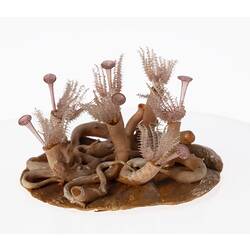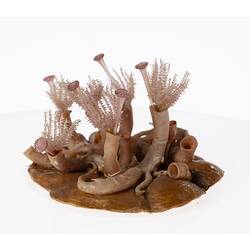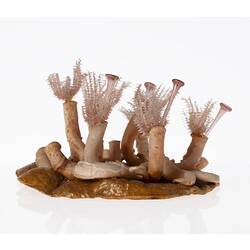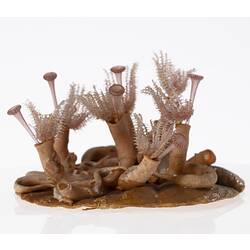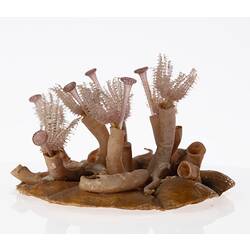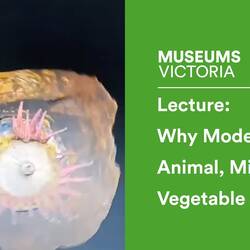Summary
This spectacular model is the work of the Blaschka father and son team of German glass artists, who created many models of soft-bodied marine life. The subject of the model, Serpula vermicularis, is a small tube worm, typically a few centimetres long in life, but microscopic examination reveals intricate structures well-suited to the sculptural skills of the Blaschkas, who clearly observed their subjects in great detail.
Serpula vermicularis belongs in the family Serpulidae, part of the phylum Annelida (segmented worms). Within this vast phylum are more familiar worms including sandworms and lugworms (sought by anglers as fish bait) and the earthworms.
This particular species is found in shallow water and intertidal communities and is widespread in the North Sea where the Blaschkas worked. Each worm lives in a smooth white calcareous tube which usually occur individually, but in suitable conditions their developing larvae may settle together to form loose aggregations or even dense reefs. A related species, Galeolaria caespitosa, is very common in southern Australia where it forms dense coral-like growths around pier piles and on rocky reefs in the intertidal zone. The worms feed by extending a crown of feathery feeding tentacles to capture planktonic prey. When threatened (and when the tide goes out) they withdraw in an instant into their tube, which is closed, hobbit-like, by a "door" a knobby structure which is a modified feeding tentacle. The door, called an operculum by scientists, often has many almost gothic spikes and hooks which no doubt deter predators who might try to eat the worm inside. The same structures are of great assistance to taxonomists in distinguishing the many species in this diverse family.
Specimen Details
-
Collection Names
-
Taxon Name
-
Author and date of publication
Linnaeus, 1767
-
Date Identified
17/01/2019
-
Identified By
Chris Rowley - Museum Victoria
-
Number Of Specimens
1
-
Specimen Nature
Nature: model, Form: dry
-
Category
-
Scientific Group
-
Discipline
-
Collecting Areas
-
Type of Item
Taxonomy
-
Kingdom
-
Phylum
-
Class
-
Order
-
Family
-
Genus
-
Species Name
vermicularis


